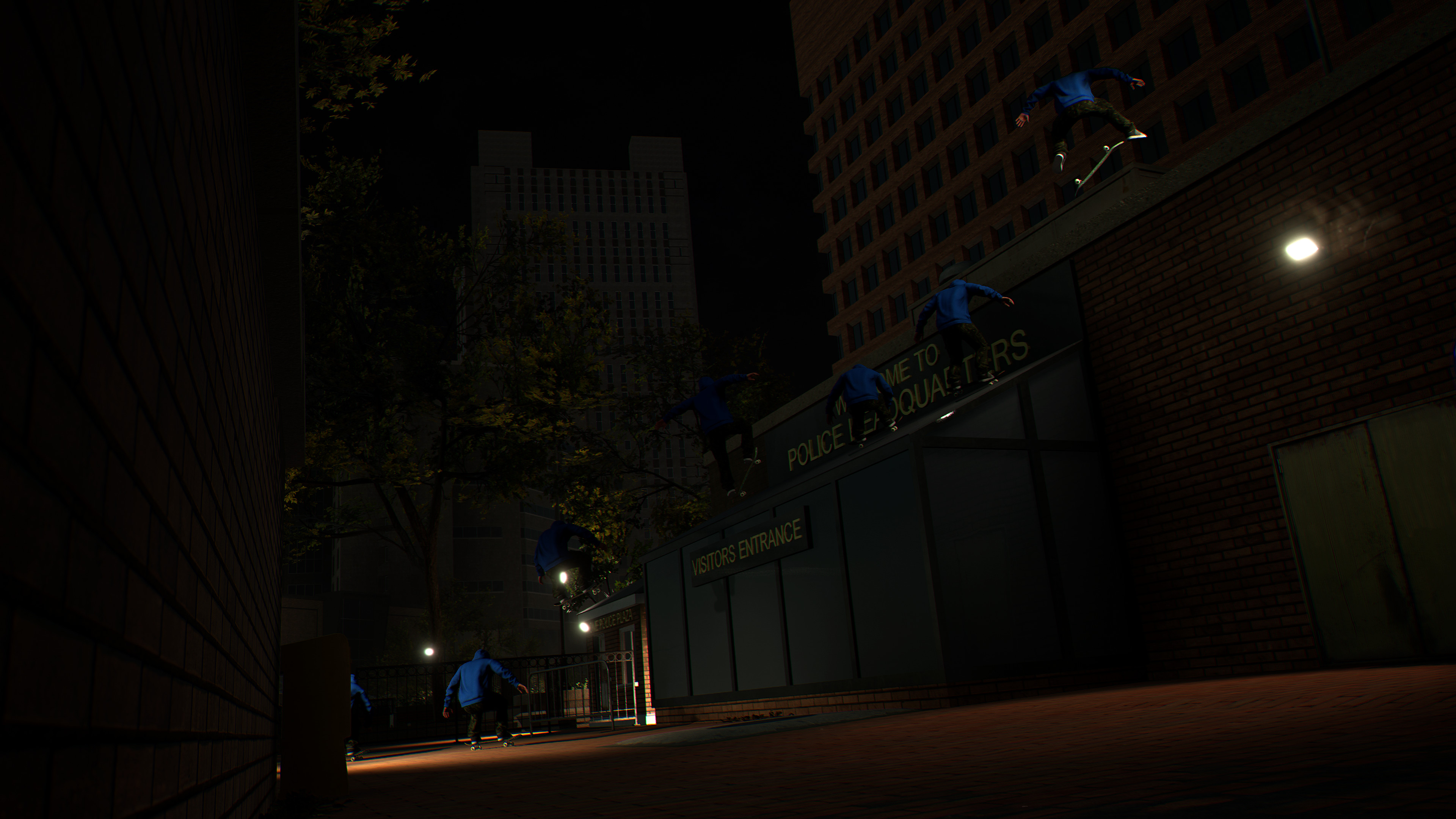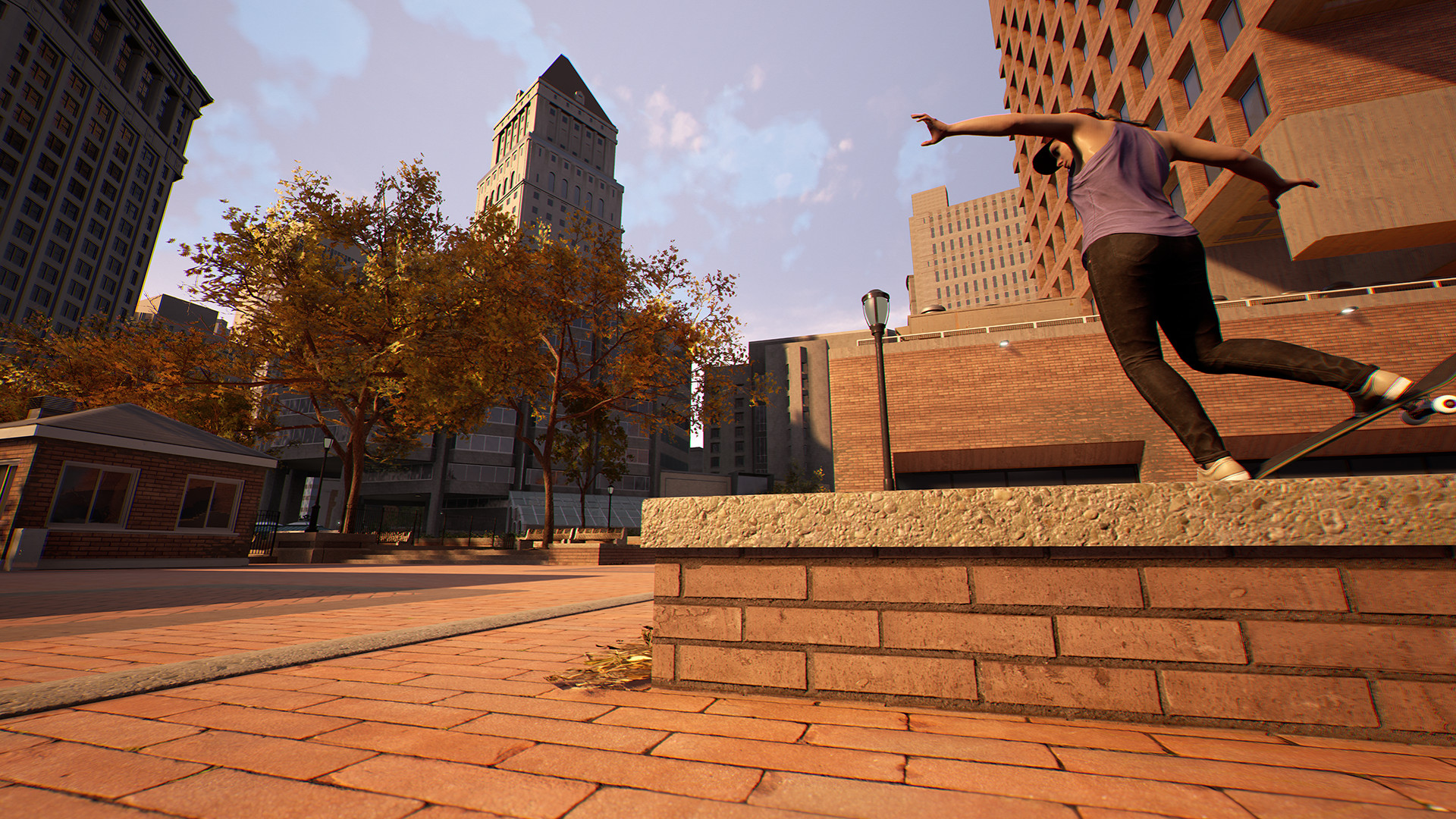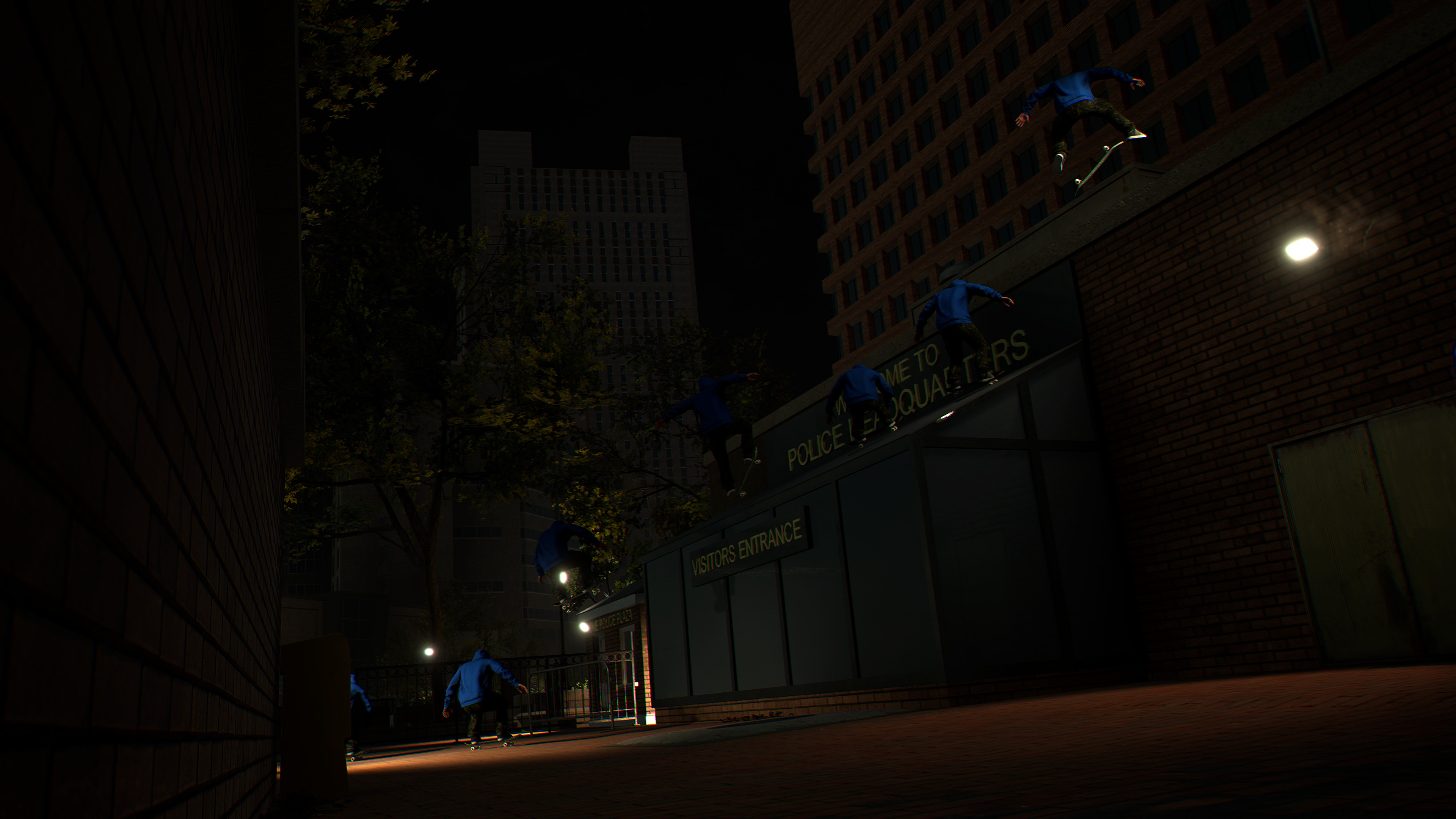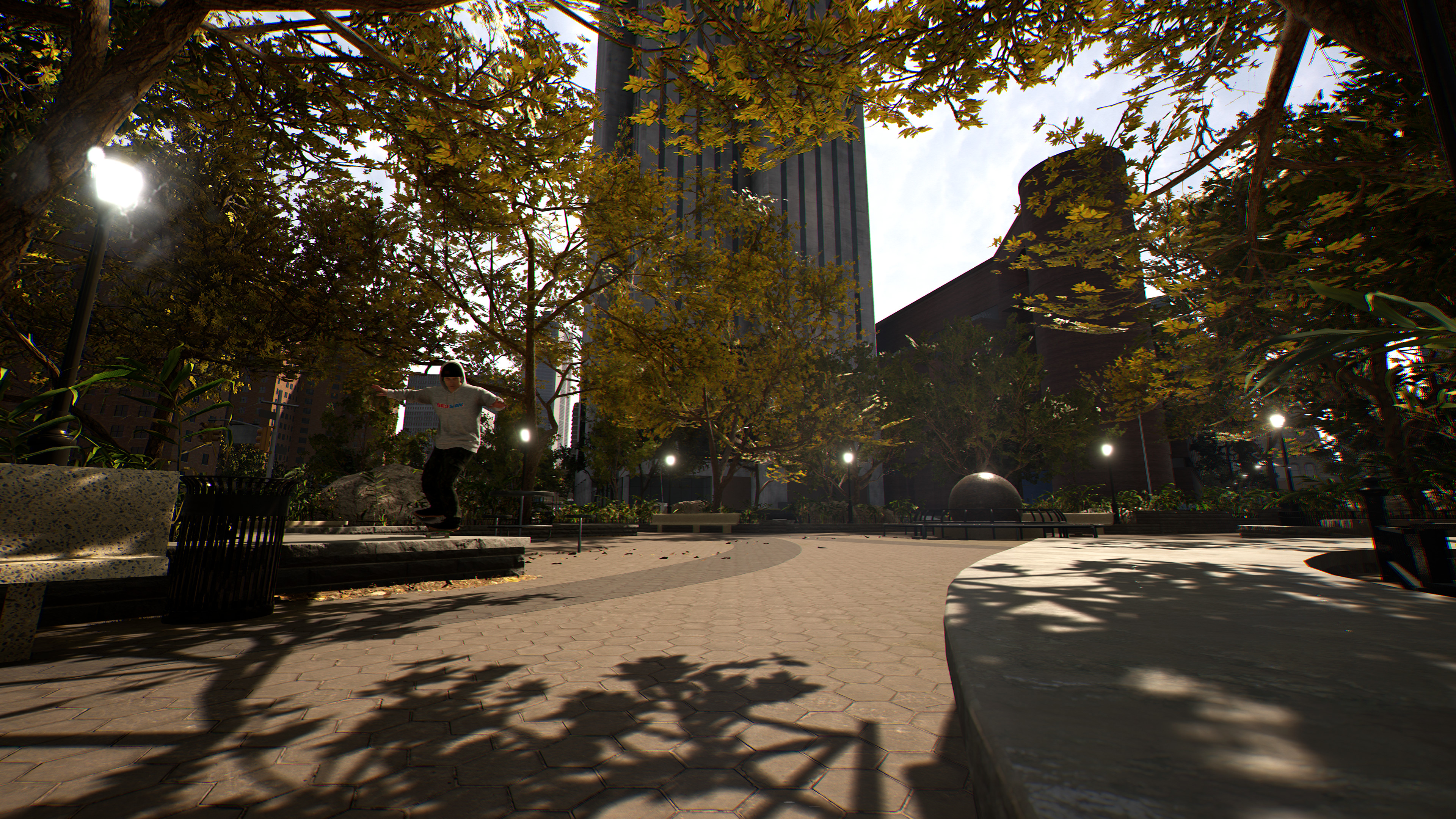Behind the Scenes on ‘Session,’ the Game Picking up the ‘Skate 4’ Torch
Credit to Author: Austin Walker| Date: Tue, 17 Sep 2019 19:22:57 +0000
If you saw my first five minutes with Session, the new skateboard sim from crea-ture Studios which enters early access on PC today, you might think I was a competent digital skater. Flicking my controller’s thumbsticks, each one controlling one of my on-screen character’s feet, I was nailing kickflips all across New York’s financial district. Then I saw it: An extremely grindable rail. And for the next 20 minutes, I fell on my ass. Repeatedly.
Session’s (understandably limited) version of lower Manhattan is filled with good skate spots, so I don’t know what it was that drew me to this one rail, which led from an elevated, high-commerce plaza down 15 steps into nondescript, business-casual walkway. It felt elemental somehow: the angle of approach, the dimensions of the rail, the distance down. If you’d asked me to imagine a cool place to grind at, I might instinctively describe this place. It was the first time since EA’s oft pined-for Skate series that I’d had this drive to nail just one trick.
And I’m not too proud to admit it: I was trying to show off for Marc-André Houde and Vincent Da Silva, co-founders of developer crea-ture Studios.. That’s probably why each attempt I made got more complicated, as I tried to develop a simple ollie into some sort of amateurish pop shove-it, boardslide combo. I slid my fingers in increasingly arcane maneuvers, imagining videotape perfection. Instead, I busted my ass over and over and over. Until, finally…
It felt great. It wasn’t the external validation of the room being impressed that I’d nailed the trick (which I’m sure they thought was a pretty basic maneuver). It was that I’d seen a spot, imagined an outcome, and nailed in. (And thanks to Session’s built in video editing tools, the team was able to cut a quick highlight from a good angle for me.)
This was only a small part of my hour spent with Session, Haude, and Da Silva while the two were in town last month to show off their game. While we passed around the controller and encouraged each other to take on increasingly ambitious runs, we also chatted about the team’s history, their vision for their dream skateboarding game, game difficulty, and an influential trip to some of New York’s legendary skate spots.
This interview has been edited for clarity and brevity.
VICE Games: Session goes into early access on September 17. How long will you have been working on the game up until that point?
Houde (Creative Director, crea-ture Studios): The two of us officially started working on this game in April 2017. We did try some stuff earlier. We did kind of a proof of concept video to try to get a grasp on if people wanted a new skateboarding game. To kind of get a feeling for expectations and all that.
After that we had a pretty big hiatus of mostly nothing. We did try, but with both of us working full time it wasn’t really possible to do this game. Up to the point where we decided to legit pitch the game to the Canadian Media Fund (CMF). We pitched the game, it was really well received. We managed to get enough money to work on a prototype first.
That was April 2017, which is pretty much when we started. After that we worked for five or six months to work on the Kickstarter prototype. We launched [that], and it went super well. We doubled the amount we wanted, and we got funded in less than two days.
How important would you say the CMF was? Is this a situation where without the CMF, you wouldn't have been able to build enough to get the Kickstarter attention that you needed?
Definitely. The first chunk of the CMF [funding] was a healthy chunk towards it, but the reality is that making games is pretty crazy expensive sometimes. So what we had at that time was just enough to come up with a really bare bones prototype. Which is why we went towards Kickstarter.
Da Silva (Tech Director, crea-ture Studios): Yeah, we could've done it over nights and weekends, but at that point we wanted to commit to it, and [develop the game] in the next ten years, but sooner rather than later.
I bring it up only because, in the United States we don't have anything like the CMF or other big government funding structures for game development. So it's interesting to hear a story about a small team that got to follow their dreams and build a game because they got this little bit of starter money.
Houde: Obviously it was a really great push to start. Without it, I don't think we would've been able to go full time at all. Because we both have families, and as much as we love making games, it's a pretty big leap to be like: "Alright!" You know? We've both been making games for 15 years, obviously we were being well paid. It's a big step to just like "Alright, fuck that crazy cool paycheck. We're gonna eat peanut butter sandwiches for the next two years!" [Gestures to the game on the screen] So, to get here, this is pretty dope.
So talk to me about it! Gimme the rundown on Session.
So, Session is a skateboarding game, as you can see. [Laughs] We started this prototype in like 2017, and the vision of the game is really different compared to all the others that we've seen. Not just because [you control the game] using analog sticks—EA's Skate did the same. We just expanded the concept in a way. We were highly inspired by Skate and have a lot of respect to the concept of that game.
But from there, we still felt that something had never been approached for skateboarding, and that was the authentic feeling of the thing. Skateboarding is hard. It takes a lot of patience. It's 90 percent mental, 10 percent physical, because you need to commit. And all of that has just never been transferred to a video game.
So when we came up with the one-stick-one-foot concept, we felt like we were getting much closer to authenticity. This is the closest we've ever been to skateboarding, in the sense that you'll learn how to do the same motion that a skater would do, but with the sticks. But we go beyond this, because we're changing the way you skate based on the stance you're using.
For example, let's say you were a regular stance guy: pushing down with the right stick would get you ready for a flip trick [because the right stick controls your right leg, which is at the rear of the board in a regular stance.] And after that, by pressing left up, you'd be mimicking the motion of an ollie. If you want to kickflip, you'd just flick to the left or right [on the left stick]. And after that, if you want to do a pop-, I mean, I don't know how used to skateboarding terms you are?
I grew up playing every Tony Hawk game, I've played some of the Skate games.
So if I say "pop shove it," you're not going to get lost?
[Laughing] No, you're good, you're good!
Okay, so if I want to scoop my board, this is where I… [Maneuvering on the controller], still go down, but this time I'm going to shove my foot backwards, and then… [lands a pop shove it.] And then, you can start combining things, hard flips and everything like that.
Once all of that is digested, you can start to spice up things. So, to nollie, you'd push up on your front foot's stick, and then pressing down to actually do a nollie.
So this is where we sort of fell in the love with the stick-per-foot concept, because now, when you switch, it's much harder. Like in real life, you're gonna fight even more to land something.

How long was it into development before you figured out the one-stick-one-foot thing?
Da Silva: That was actually one of the first prototypes we did. It was back in Unity. It was just a guy standing on spot, and you were just flicking it to pop up and do tricks. And then we went "okay, let's do the banking."
Houde: And the banking was a pretty bold move because with this concept, it's pretty much like saying to all the players out there "Hey, you know how you're used to turning left and right on the right thumbstick? Unplug that chip from your brain, and plug in turning on the triggers.
At first we were pretty nervous about this, because it was unseen before this, so we couldn't know how [it would feel or how people would react to it.] So we started to test it internally. I remember I was headed to a restaurant, and [Da Silva] called me and said "Dude, I have the banking on the triggers now." I said "Oh shit, how does it translate?" and he said "It's fucking hard… but you can get some really good stuff."

Is the reason for putting banking on the triggers because it lets always think about your sticks in terms of foot movement and tricks?
Exactly. So this is where it all made sense. [Grips the controller deliberately.] It was great, because you were locked to your controller. Your thumbsticks are your tricks, your shoulder buttons are you're turning. That's it. That's what you need to care about. Those no "if you're on the ground, this button does this, but if you're in the air it does that." No. It's just about the tricks you can do with those sticks.
One thing we didn't expect was how precise the triggers are compared to the sticks. When you get grasp on small movement, this is where you can jump and get, like, super slow 180s and things like that. But the turning is definitely the biggest learning curve we have. This whole concept was really about giving a really solid feel of what skateboarding really is.
[Haude takes the controller and moves to a new location.]
What I'm trying here is to kind of show how we envision Session. It's not like the other games where you cruise around and do tons of cool tricks and you never stop if you don't want to. Here it's more like real life: you're going to scout out the city, and find a really good spot and you're gonna think how can I find a run through this, what cool stuff can I do here?

[Haude nearly sticks a series of tricks, ending in a grind, but falls at the end.] I'm just going to… [He goes into the options to change the time of day.]
Da Silva: Ohhhh, now it's the time of day! Last time it was the laptop [that made you miss the trick]!
Haude: Just like real skateboarding! Oh, the wax is too cold!
Da Silva [rooting him on]: Come on! You've done this so many times.
Haude: So this is what we're really trying to achieve. Even though I'm playing this game every damned day, I'm still having a blast just trying to get this run… [A minute or two later, he lands it, and the room claps for him.]
And at that point, we can build a montage. Because the whole premise of the game is "skate, film, and share." You do a trick, and when you're proud of it, you can use the in-game video editor to put it together. There's not a lot of gamification, here.
So basically, are players going to be getting the game, loading it up, skating, filming, and that's it?
At first it was pretty much that idea in a nutshell: Just focus on skating. But at some point we found out that while that was working, it was appealing much more to pure skaters. For them, it was like they were kids in a candy store: Oh my god, there are so many spots! This is insane! I'm gonna skate this place forever!
But then you get someone who's like a skate enthusiast, someone who hasn't skated for 20 years, and they say "Wow, this is so cool… What do I do?" And they get kind of overwhelmed because you can [skate around and do tricks], but there's no help.
And this is where [Da Silva] came up with the challenge system. He is not a skater, but he understands the culture now, and said that he liked the game best when skaters were telling him to try this or that. So, now we have daily and weekly challenges for you to do in the game, which helps to lead the player towards something to do.
What are those challenges like?
For example, you go into this plaza, that has six of these big blocks? One challenge might be to grind all six blocks. Or, do a hundred meters of manuals in one day.
We're always trying to keep things open, we're not trying to dictate what to do. We wouldn't say "Do a 360 flip into a nose manual, then nollie flip out." That's not the thing. If you want to do that nollie flip out, that's on you, and you'll be happy about it. But we never want to force the player to do anything like that.
Will there be any sort of unlockable fashion things, boards, decks, etc.?
Your character will be customizable right off the bat in early access, and coming up, we'll let you trade in your challenge points at a No Comply skate shop for more stuff, too.
We also made sure to include female character customization. I think it's about time that women [skaters] get a bit of the spotlight. That should be [normal]. Women have been in this community for years, and haven't had a chance for that spotlight. So we want to be really fair with this portion of Session.
Is there just this one city space for now?
Yeah, right now, we're working on a small section of the Financial District of New York. You're from here, so you probably recognize some key places here: The Verizon Tower here… and if you keep skating in this direction, you're going to arrive at the Brooklyn Banks.
We'd like to expand into the historical district, and other cities, but for now we wanted to make sure this really felt like the city. We already have a fast-travel system, if you go to a bus station, you can go to a bunch of different spots around the map. We'll expand that to new locations in the future, like even if you just go across the Brooklyn Bridge you have some really crazy cool skate spots that we want to recreate.
We decided to go with New York because we felt that, especially for the east coast, this area played a major role in skateboarding and skate culture.

Is there one area that really sticks out to you?
Yeah, the Brooklyn Banks. That's the area we had the most fun putting together and polishing. We wanted to use the Banks as like a benchmark for what we wanted to achieve with the game. We went crazy trying to replicate this place perfectly. You have the same amount of arches and pillars and backstreet. We opened up Google maps, took down all the metrics we could to make sure everything was the same height and same distance and everything.
Then, when I came to New York, I snuck into the Banks to take a ton of photos, and there were a ton of skaters there. They were telling me not skate there because they were afraid I would get them kicked out.
It was really cool. I was having so much fun, because I was with my girlfriend, and she was waiting for me on the other side and she was super stressed. We're in the States!
Was this at night?
It was right in the afternoon! I went there it was like… this is fucking awesome. This is skateboarding. I was trying to take in everything, and it was like this is everything we want to capture in Session.

I noticed that there are a lot of options for changing how different things work, like whether I want to be able to keep spinning indefinitely when I hold down the triggers. What went into deciding those?
Da Silva: We wanted to make sure that players had a lot of options to try to let them customize their experience.
Haude: We're still working on making sure everyone has a good experience. This is kind of a hard game, you know? It's pretty hard core. We know that, and we don't want players to feel like this is exclusive to skaters, like a "locals only" kind of thing. That's why from the start we wanted to include as many options as you can.
Where your options are set now, you'll get is sort of a hybrid between hardcore simulation and a more simplified game with some automated stuff. But if you wanted to go even more hardcore, you could turn on manual flipping speed, manual catching, so you'd have to wait until the board flips under your feet before you catch it.
The real purists are getting excited because of all that stuff. But we know it's not for everyone either.
"Look, if it sells well we're not gonna complain! But we're not going to change our concept so that it makes more money."
How do you know where to set the default settings? You know imagining a player who opens it up for the first time… Is it that you turn on every little thing that can help them? Or do you want to retain that challenge?
Da Silva: Yeah, totally. I think [both Haude and I] agree that our default settings will be not necessarily full hardcore, but it will not be for the average player either. We know the game is hard. We've said that it's hard. And we want to make sure that's the base experience. Not at the hardest, not at the easiest, but somewhere in the middle.
Haude: One thing that we really are trying to do with this is to represent skateboarding, or what skateboarding is to us. That's our main goal. We're not going to dumb it down to reach a wider audience.
It's definitely not an arcade game.
Yeah, exactly. Our main purpose is… I mean, look, if it sells well we're not gonna complain! But we're not going to change our concept so that it makes more money. That's how we think about this.
But that mindset doesn't mean that we have to say "fuck off" to everyone who can't play it on the default settings. Games like Grand Turismo or Forza are big inspirations, because they have this level of kind of complexity and simulation, but with the option to ease players into it.
This is a big, ongoing discussion in games right now, both in terms of accessibility and approachability. Which is tough for a game like this, where the core concept, as you've pitched it, is "one foot, one stick," which seems like it limits things like controller remapping in some ways.
Da Silva: Yeah, but even there, we wanted to make sure to include an option to let you play front foot-back foot instead of left foot-right foot. So that that players who have trouble with how the controls change when you switch into a Goofy stance [where your left foot is forward].
Haude: We're opening up the gates to make it more approachable, so long as it doesn't betray that core concept. We used to work in big studios, and it was getting frustrating when we'd hear things like "My mom should be able to play this." Yeah, well, your mom doesn't give a fuck about snowboarding games!
Are you interested in skateboarding or the culture? Then we want you to be able to play the game. If you're not, we don't want to bend over backwards to try to get you to play this. That's how we feel about skating.
How are you feeling about going into Early Access?
Da Silva: You know, we've already postponed it a lot [so that we can get the game into a more polished state]. But the whole point is to get player feedback and to get the community involved. So you know, we're aware there are going to be issues. But it's in early access and we're trying to put the best product out that we can.
We feel like it's ready for us to get people involved and to start showing it. Could we use another month? Yeah, sure, but that's game development.
And you'll get that extra month, it's just that it will be in early access during it.
Haude: Exactly. That month is going to give us tons of feedback, and that's what's exciting about early access, getting shit tons of feedback. That's why, from almost the beginning, we've been showing stuff. The concept wasn't even done before we were talking to the community. We were asking what they thought of the way we were handling grinds and grabs and everything really early.
Honestly, there's risk [with early access] because everything is open. But that's a risk we accept.
Right now, there aren't a ton of skateboarding games coming out. Do you think there has been a big desire for something like this since Skate 3 ? Do you think there was a desire for something even more hardcore than that?
Yeah, I think there's always been a group of people eager to play a super realistic game. I think the Skate franchise showed that. Without EA's Skate I don't think we could've come out with a hardcore game like this. The gap between us and Tony Hawk would've been way too big. The two sticks, the triggers, it's a big ask.
Have you run into situations where players who just don't get it at all?
Da Silva: Not really. Some people get it in five minutes, some people get it in 30. But for the most part, people are able to get over that little hurdle of the triggers being weird and everything.
How has the response been from the skateboarding community so far?
Haude: I think a lot of people out there are just excited about this being a realistic skateboarding game. As a skater, I'm excited about this because we have about eight months of winter in Montreal, Quebec. So this is going to be my skate session.
You know, I'm not much of an inside skate park guy, and I'm getting old, so as soon as it's winter, and I get home, being able to play this is great for me. Skateboarding is dear to my heart. This is our love letter to skateboarding.
Have thoughts? Swing by the Waypoint forums to share them.
This article originally appeared on VICE US.